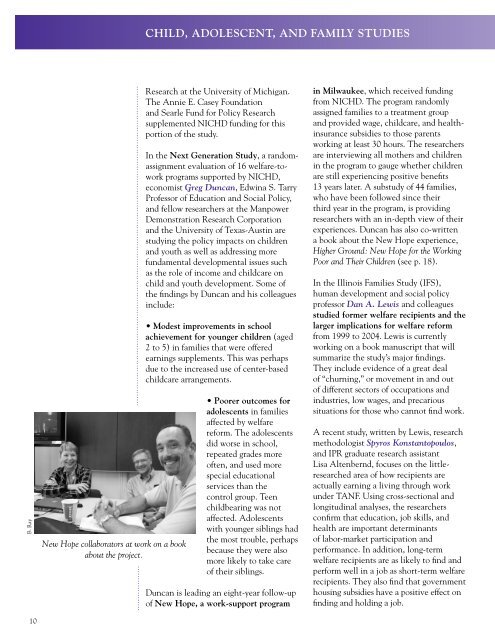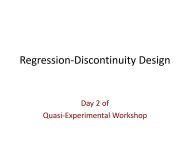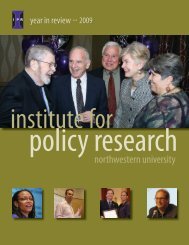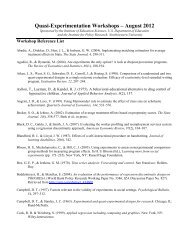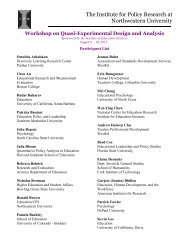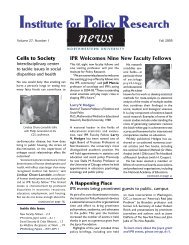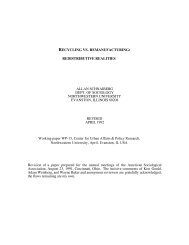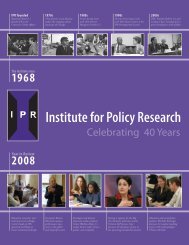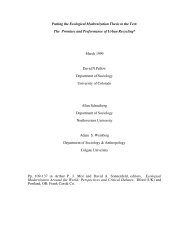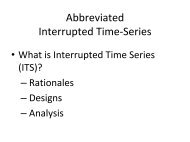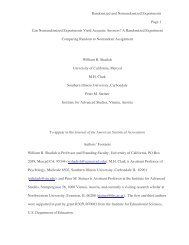pdf - Institute for Policy Research - Northwestern University
pdf - Institute for Policy Research - Northwestern University
pdf - Institute for Policy Research - Northwestern University
You also want an ePaper? Increase the reach of your titles
YUMPU automatically turns print PDFs into web optimized ePapers that Google loves.
B. Ray<br />
Child, Adolescent, and family studies<br />
10<br />
New Hope collaborators at work on a book<br />
about the project.<br />
<strong>Research</strong> at the <strong>University</strong> of Michigan.<br />
The Annie E. Casey Foundation<br />
and Searle Fund <strong>for</strong> <strong>Policy</strong> <strong>Research</strong><br />
supplemented NICHD funding <strong>for</strong> this<br />
portion of the study.<br />
In the Next Generation Study, a randomassignment<br />
evaluation of 16 welfare-towork<br />
programs supported by NICHD,<br />
economist Greg Duncan, Edwina S. Tarry<br />
Professor of Education and Social <strong>Policy</strong>,<br />
and fellow researchers at the Manpower<br />
Demonstration <strong>Research</strong> Corporation<br />
and the <strong>University</strong> of Texas-Austin are<br />
studying the policy impacts on children<br />
and youth as well as addressing more<br />
fundamental developmental issues such<br />
as the role of income and childcare on<br />
child and youth development. Some of<br />
the findings by Duncan and his colleagues<br />
include:<br />
• Modest improvements in school<br />
achievement <strong>for</strong> younger children (aged<br />
2 to 5) in families that were offered<br />
earnings supplements. This was perhaps<br />
due to the increased use of center-based<br />
childcare arrangements.<br />
• Poorer outcomes <strong>for</strong><br />
adolescents in families<br />
affected by welfare<br />
re<strong>for</strong>m. The adolescents<br />
did worse in school,<br />
repeated grades more<br />
often, and used more<br />
special educational<br />
services than the<br />
control group. Teen<br />
childbearing was not<br />
affected. Adolescents<br />
with younger siblings had<br />
the most trouble, perhaps<br />
because they were also<br />
more likely to take care<br />
of their siblings.<br />
Duncan is leading an eight-year follow-up<br />
of New Hope, a work-support program<br />
in Milwaukee, which received funding<br />
from NICHD. The program randomly<br />
assigned families to a treatment group<br />
and provided wage, childcare, and healthinsurance<br />
subsidies to those parents<br />
working at least 30 hours. The researchers<br />
are interviewing all mothers and children<br />
in the program to gauge whether children<br />
are still experiencing positive benefits<br />
13 years later. A substudy of 44 families,<br />
who have been followed since their<br />
third year in the program, is providing<br />
researchers with an in-depth view of their<br />
experiences. Duncan has also co-written<br />
a book about the New Hope experience,<br />
Higher Ground: New Hope <strong>for</strong> the Working<br />
Poor and Their Children (see p. 18).<br />
In the Illinois Families Study (IFS),<br />
human development and social policy<br />
professor Dan A. Lewis and colleagues<br />
studied <strong>for</strong>mer welfare recipients and the<br />
larger implications <strong>for</strong> welfare re<strong>for</strong>m<br />
from 1999 to 2004. Lewis is currently<br />
working on a book manuscript that will<br />
summarize the study’s major findings.<br />
They include evidence of a great deal<br />
of “churning,” or movement in and out<br />
of different sectors of occupations and<br />
industries, low wages, and precarious<br />
situations <strong>for</strong> those who cannot find work.<br />
A recent study, written by Lewis, research<br />
methodologist Spyros Konstantopoulos,<br />
and IPR graduate research assistant<br />
Lisa Altenbernd, focuses on the littleresearched<br />
area of how recipients are<br />
actually earning a living through work<br />
under TANF. Using cross-sectional and<br />
longitudinal analyses, the researchers<br />
confirm that education, job skills, and<br />
health are important determinants<br />
of labor-market participation and<br />
per<strong>for</strong>mance. In addition, long-term<br />
welfare recipients are as likely to find and<br />
per<strong>for</strong>m well in a job as short-term welfare<br />
recipients. They also find that government<br />
housing subsidies have a positive effect on<br />
finding and holding a job.


